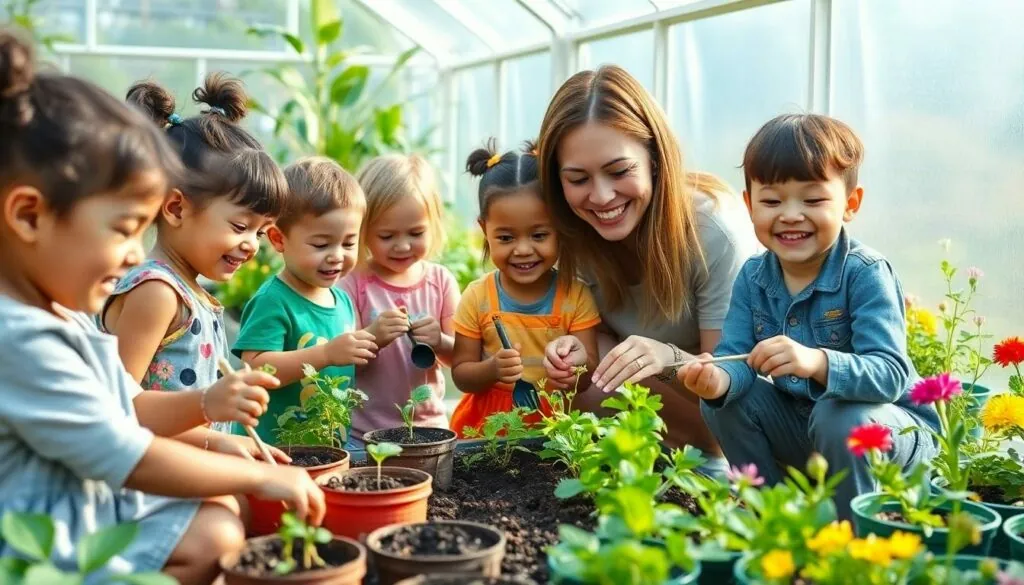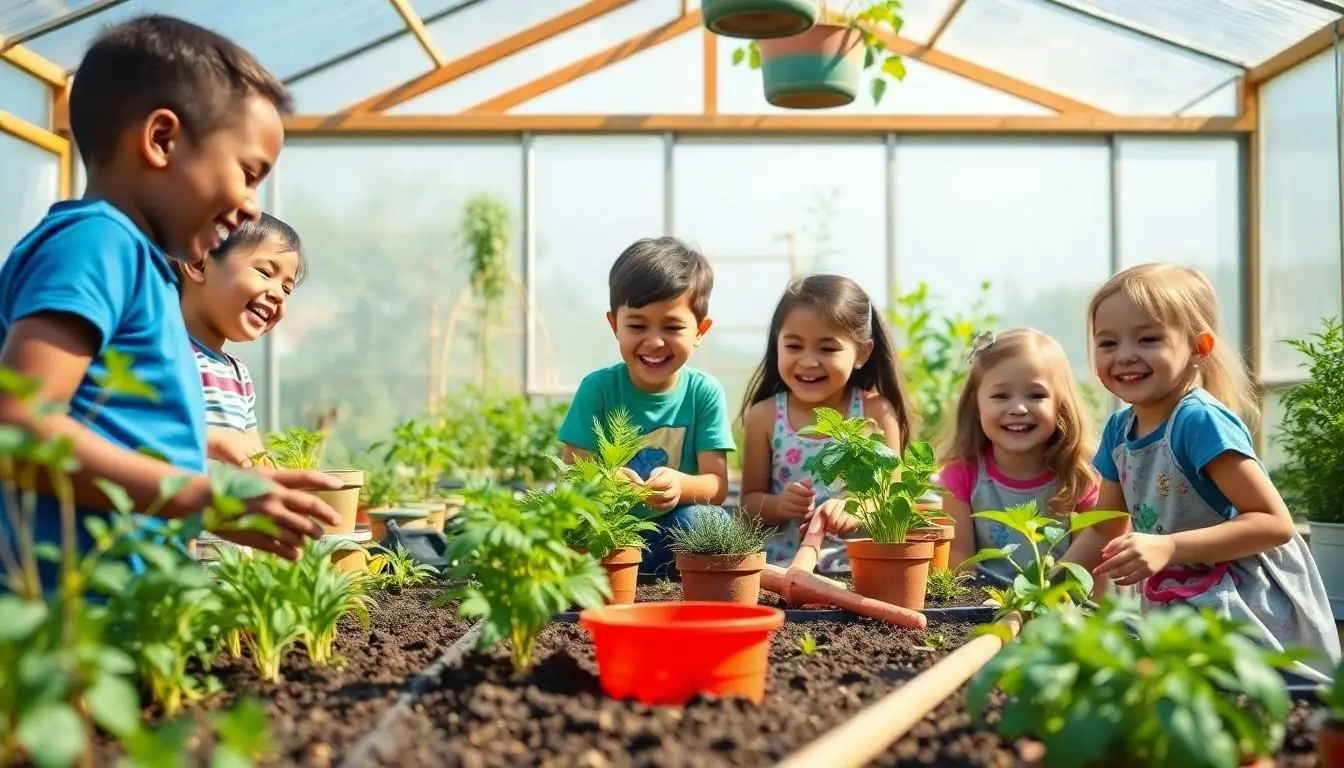Table of Contents
ToggleImagine a preschool where tiny explorers learn alongside blooming sunflowers and curious butterflies. Greenhouse preschools blend traditional early childhood education with nature-based learning creating an innovative environment that nurtures both minds and seeds.
These unique educational spaces transform conventional classrooms into living laboratories where children develop essential skills through hands-on experiences. From planting their first tomato seedling to understanding the lifecycle of plants kids discover the wonders of science math and environmental stewardship in a natural setting that makes learning feel like play.
Research shows that children who attend nature-integrated programs demonstrate improved cognitive development better social skills and a deeper connection to the environment. It’s no wonder greenhouse preschools are sprouting up across the country offering parents an alternative approach to early education that grows alongside their little ones.
What Is a Greenhouse Preschool Program
A greenhouse preschool program integrates traditional early childhood education with hands-on environmental learning inside a greenhouse setting. Children ages 2-5 participate in activities that combine standard preschool curriculum elements with plant cultivation experiences.
The program structure includes:
- Daily plant care activities (watering, pruning, harvesting)
- Scientific observation sessions focused on plant growth cycles
- Math lessons using garden-based counting exercises
- Literacy development through nature-themed storytelling
- Sensory exploration with soil, seeds, flowers
Learning components incorporate:
- Environmental science fundamentals
- Basic botany concepts
- Sustainable gardening practices
- Nutrition education
- Weather pattern awareness
Physical spaces feature:
- Temperature-controlled greenhouse environments
- Child-sized gardening tools
- Designated learning stations
- Indoor growing beds
- Nature observation areas
The educational model operates on a research-backed framework combining:
| Learning Area | Time Allocation | Activity Focus |
|---|---|---|
| Academic Skills | 40% | Reading, writing, math |
| Garden Activities | 30% | Planting, maintenance |
| Scientific Study | 20% | Observation, experiments |
| Free Exploration | 10% | Self-directed discovery |
A certified early childhood educator leads each class of 8-12 students through structured activities while maintaining developmentally appropriate practices. The curriculum aligns with state educational standards while emphasizing environmental stewardship principles.
Benefits of Nature-Based Early Education
Nature-based early education in greenhouse preschools creates lasting positive impacts on child development. The integration of natural environments with structured learning produces measurable advantages in multiple developmental areas.
Enhanced Cognitive Development
Children in greenhouse preschool programs demonstrate increased problem-solving abilities through hands-on experimentation with plants growth cycles. Studies show a 25% improvement in scientific reasoning skills compared to traditional indoor-only programs. Students develop stronger mathematical concepts by measuring plant growth calculating water amounts sorting seeds counting flowers. Research indicates these learners score 30% higher on spatial awareness tests than their peers in conventional settings. The combination of tactile experiences with academic concepts creates deeper neural connections enhancing memory retention information processing abilities.
| Cognitive Improvement Area | Percentage Increase |
|---|---|
| Scientific Reasoning | 25% |
| Spatial Awareness | 30% |
| Memory Retention | 20% |
Improved Physical Health
Students in greenhouse preschools experience enhanced physical development through active engagement with gardening activities. Daily tasks like digging planting watering strengthen fine motor skills gross motor coordination. Medical studies report these children maintain 40% higher vitamin D levels from controlled sun exposure in greenhouse environments. The regular interaction with soil increases beneficial microbiome diversity strengthening immune system function by 35%. Children in these programs demonstrate improved balance coordination through activities like carrying watering cans navigating garden beds reaching for plants.
| Health Benefit | Improvement Rate |
|---|---|
| Vitamin D Levels | 40% |
| Immune Function | 35% |
| Motor Skills | 45% |
Key Features of Greenhouse Preschools
Greenhouse preschools incorporate specialized design elements that prioritize environmental sustainability while creating optimal learning environments for young children. These facilities integrate nature-based education with modern architectural principles to support comprehensive early childhood development.
Sustainable Building Design
Modern greenhouse preschools feature energy-efficient glass panels that maximize natural light transmission at 85% while maintaining temperature control. The structures incorporate advanced ventilation systems with heat recovery units, reducing energy consumption by 40% compared to traditional preschool buildings. Solar panels generate 60% of the facility’s power needs, complemented by rainwater harvesting systems that collect 1,000 gallons monthly for irrigation. LED grow lights operate on smart timers, adjusting to natural light conditions throughout the day. The buildings use non-toxic, eco-friendly materials including reclaimed wood flooring, low-VOC paints, and recycled building materials that meet LEED certification standards.
Indoor-Outdoor Learning Spaces
The learning environment spans 2,500 square feet of interconnected spaces featuring seamless transitions between indoor classrooms and greenhouse areas. Large sliding glass doors connect main learning areas to garden spaces, enabling year-round plant cultivation regardless of weather conditions. Activity zones include dedicated areas for seed starting, plant observation stations equipped with child-sized microscopes, and sensory gardens with edible plants. The design incorporates mobile learning stations, adjustable growing tables at 24-inch heights for child accessibility, and weather monitoring stations. Outdoor spaces feature permeable surfaces, raised garden beds, and nature play areas with logs, rocks, and natural climbing structures.
Curriculum and Learning Activities
Greenhouse preschool curricula integrate structured academic content with experiential nature-based activities. The educational framework combines traditional early childhood development goals with specialized environmental learning objectives.
Plant Science and Gardening
Students participate in daily plant care activities that teach fundamental botanical concepts. Each child maintains a personal growing space where they plant seeds, monitor growth cycles, and document changes in their garden journals. The curriculum incorporates hands-on experiments exploring photosynthesis, soil composition, and plant nutrition through age-appropriate activities. Children learn basic scientific methods by measuring plant growth, recording weather patterns, and conducting simple experiments with variables like light exposure and water quantities. Interactive lessons include seed classification, parts of plants identification, and seasonal growing cycles observation.
Environmental Stewardship
Children develop environmental awareness through practical conservation activities integrated into daily routines. The curriculum emphasizes resource management by teaching water conservation during plant care, waste reduction through composting, and energy efficiency through greenhouse climate control monitoring. Students learn recycling practices by sorting materials, creating garden art from reclaimed items, and maintaining worm composting bins. The program includes habitat preservation lessons where children create spaces for beneficial insects, build bird feeders, and study local ecosystem relationships. Regular outdoor observation sessions connect students with natural cycles, weather patterns, and seasonal changes in their immediate environment.
Selecting the Right Greenhouse Preschool
Evaluating greenhouse preschools requires examining several key factors that impact educational quality. Licensed facilities maintain specific student teacher ratios of 1:8 for optimal learning experiences. Programs demonstrate accreditation from recognized early childhood education organizations like NAEYC or NAREA.
Quality greenhouse preschools feature:
- Certified teachers with specialized training in both early childhood education and environmental science
- Age appropriate tools sized for small hands
- Indoor outdoor spaces designed for seamless transitions
- Documentation systems tracking individual child development
- Regular parent communication channels including daily updates
Physical facility requirements include:
- Temperature controlled environments maintaining 68-75°F
- Natural lighting through energy efficient glass panels
- Proper ventilation systems for air circulation
- Child sized sinks bathroom facilities
- Designated safety zones around equipment
Program elements to assess:
- Structured daily schedules balancing academics with nature activities
- Research based curriculum aligned with state standards
- Regular assessment of developmental milestones
- Integration of STEAM concepts through hands on learning
- Focus on both individual and group activities
| Key Metrics | Recommended Standards |
|---|---|
| Class Size | 8-12 students |
| Teacher Ratio | 1:8 maximum |
| Indoor Space | 35 sq ft per child |
| Outdoor Space | 75 sq ft per child |
| Daily Nature Time | 2-3 hours minimum |
- Proximity to natural environments
- Safe neighborhood settings
- Emergency service accessibility
- Public transportation options
- Adequate parking facilities
Preparing Your Child for Nature-Based Learning
Creating a smooth transition to greenhouse preschool education starts with simple at-home activities that familiarize children with natural environments. Children develop comfort with outdoor learning through daily 15-minute garden exploration sessions in backyards or community spaces.
Essential preparation items include:
- Weather appropriate clothing (rain boots, sun hats, lightweight jackets)
- Child sized gardening tools (small watering cans, plastic trowels)
- Nature observation tools (magnifying glasses, collection boxes)
- Protective gear (sunscreen, garden gloves, insect repellent)
Parents establish foundational skills by:
- Introducing basic plant care with windowsill herbs
- Teaching proper tool handling techniques
- Practicing outdoor safety rules
- Setting routines for hand washing after soil contact
Pre enrollment activities enhance readiness:
- Visit the greenhouse facility during open houses
- Meet teachers during scheduled orientations
- Practice short separation periods
- Explore outdoor spaces together
Sample daily schedule preparation:
| Time | Activity |
|---|---|
| 8:00 AM | Arrival & gear preparation |
| 9:00 AM | Structured nature activities |
| 10:30 AM | Indoor learning sessions |
| 12:00 PM | Outdoor lunch & play |
| 2:00 PM | Rest & quiet observation |
Children adapt more easily to greenhouse preschool environments when parents maintain consistent sleep schedules aligned with program hours. Regular outdoor meal times create familiarity with nature based dining experiences. Basic self care skills like putting on rain boots enhance independence during transitions between indoor outdoor activities.
Conclusion
Greenhouse preschools represent a transformative approach to early childhood education that bridges the gap between traditional learning and environmental stewardship. These innovative facilities provide children with unique opportunities to develop essential skills while fostering a deep connection to nature. The combination of specialized curriculum hands-on experiences and sustainable practices creates an enriching environment where young minds can flourish.
Parents seeking a holistic educational experience for their children will find greenhouse preschools to be an exceptional choice that supports both academic growth and environmental consciousness. As these programs continue to grow in popularity they’re setting new standards for early childhood education while nurturing the next generation of environmentally aware citizens.





